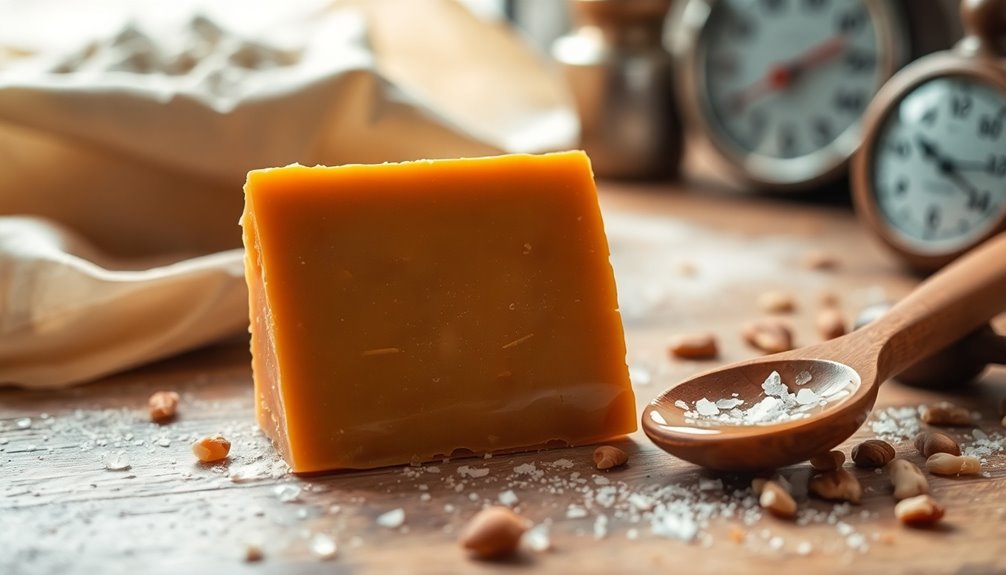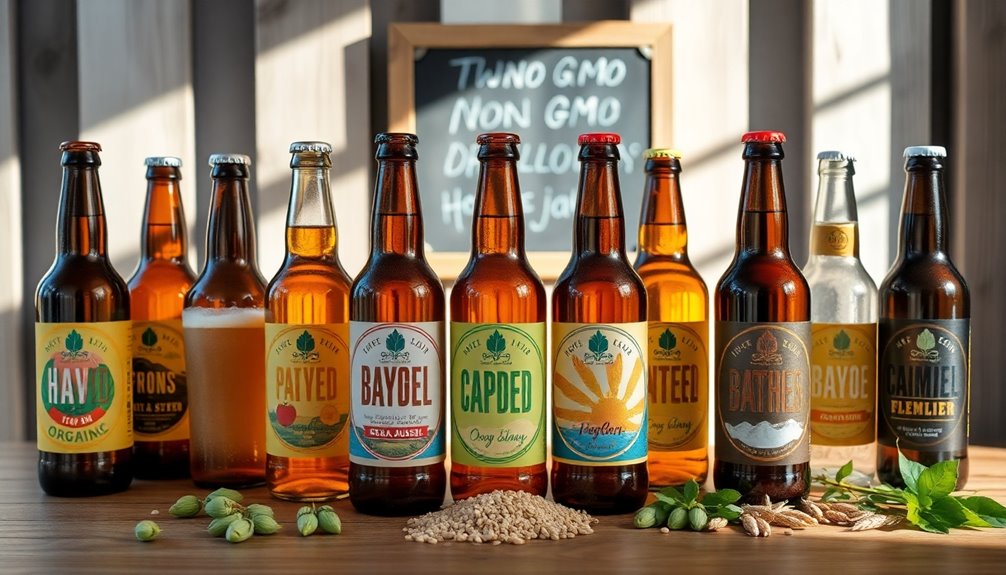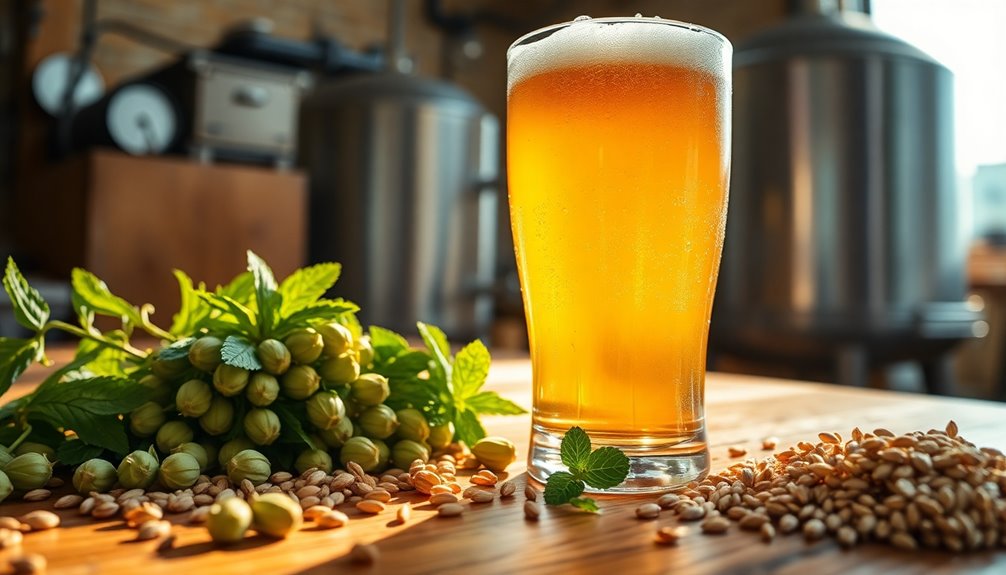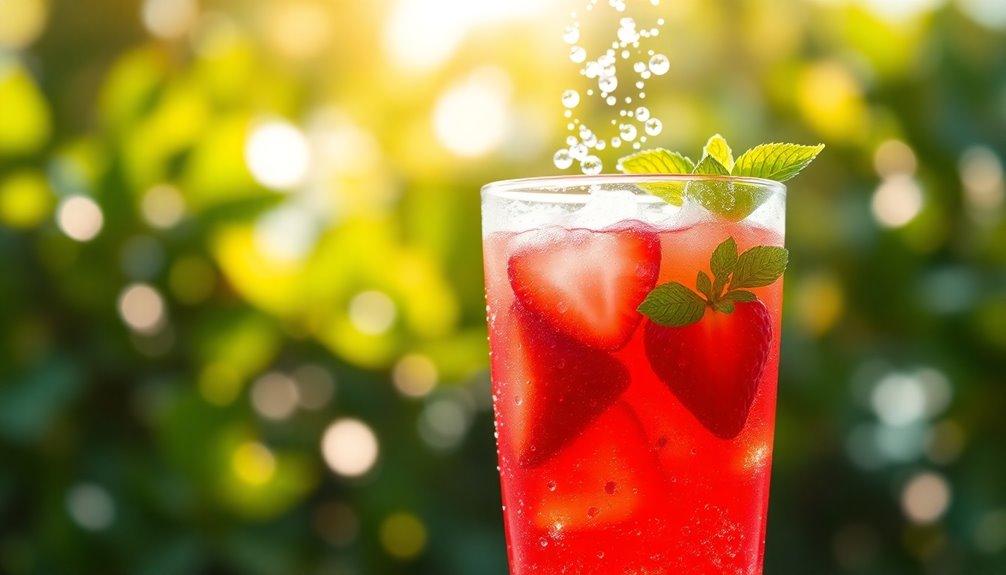You can easily create irresistibly sweet butterscotch candy at home. Start by combining brown sugar, water, and corn syrup in a heavy saucepan. Boil until it reaches 270°F, then stir in butter, salt, and rum extract. Continue cooking until you hit 300°F. Pour the mixture into a buttered pan and let it cool for a few minutes before scoring it for easier breaking. Remember, maintaining the right temperature is key to avoid texture issues. You can even experiment with different extracts for unique flavors. Want tips to guarantee a perfect batch every time? There's more interesting info ahead!
Key Takeaways
- Use a heavy saucepan to combine brown sugar, water, and corn syrup, boiling until it reaches 270°F for a smooth texture.
- Stir in butter, honey, salt, and rum extract, cooking until the mixture reaches the hard-crack stage at 300°F for the perfect candy consistency.
- Score the candy after 5 minutes of cooling to ensure easy breaking into manageable pieces once fully cooled.
- Store your butterscotch candy in an airtight container with parchment paper layers to prevent sticking and maintain freshness.
- Experiment with different extracts and spices to create unique flavor profiles that enhance your homemade butterscotch treats.
Main Ingredients
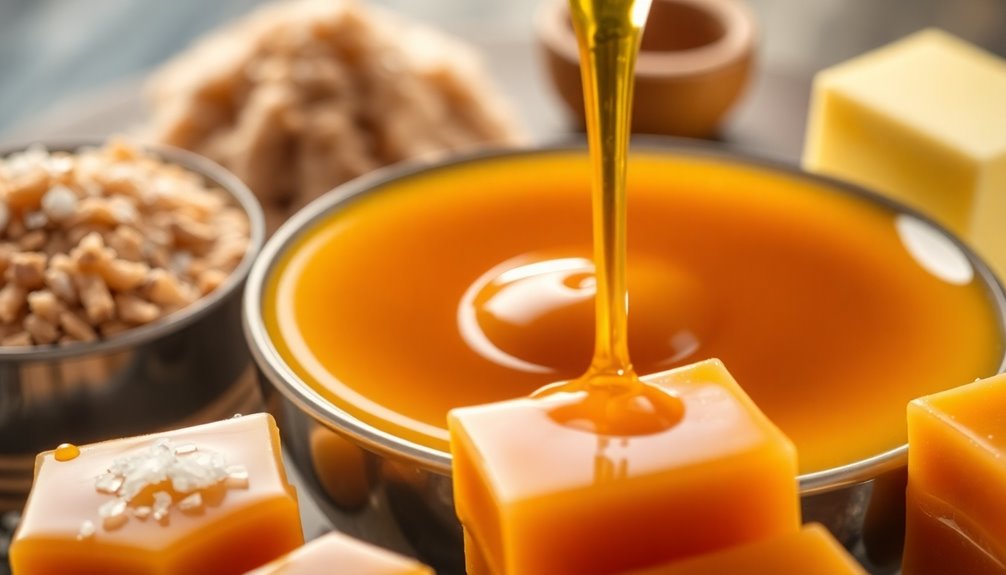
When making butterscotch candy, the right ingredients are key to achieving that rich, creamy texture and deep flavor. Start with butter, which serves as the essential creamy base, giving your candy its luxurious mouthfeel.
You'll want to use both brown sugar and white sugar; the brown sugar acts as a sweetening agent while adding a deeper, molasses-like flavor that enhances the overall taste.
Adding light corn syrup is essential, as it prevents sugar crystallization, ensuring your butterscotch has a smooth, glossy finish. This will help create that perfect texture you're after.
For an added depth, consider incorporating rum extract; it introduces a complex, caramelized flavor profile that elevates your candy.
If you prefer a different taste, vanilla extract can work as a substitute. You might also want to include a touch of honey, which not only boosts sweetness but also brings warm, floral notes that beautifully complement the buttery richness.
Cooking Instructions
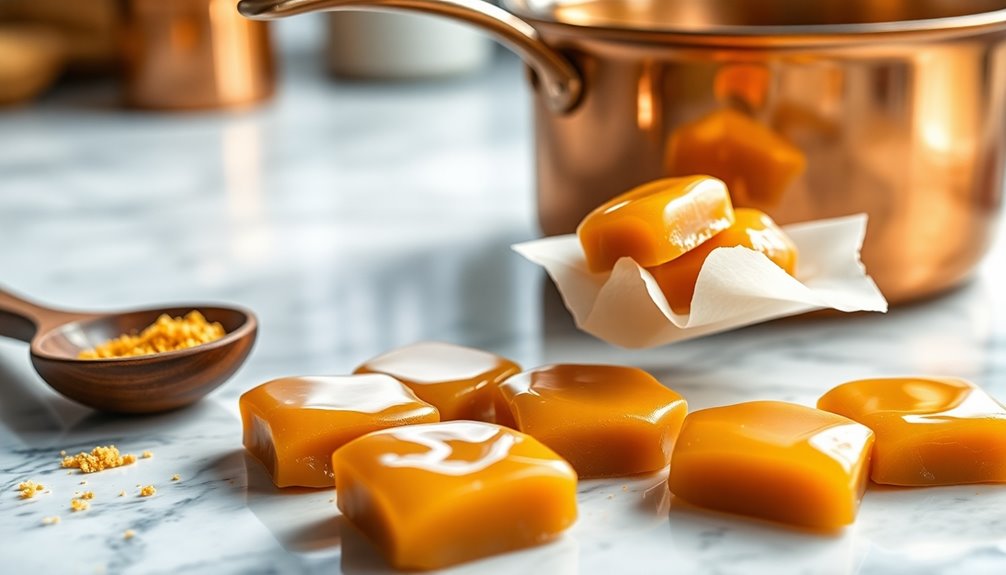
To make your butterscotch candy, start by preparing a 15x10x1-inch pan—just butter it with 1 teaspoon of butter and set it aside for later.
In a heavy saucepan, combine brown sugar, water, and light corn syrup. Cover the pan and boil the mixture over medium heat without stirring until it reaches 270°F (soft-crack stage).
Once you hit that temperature, stir in honey, butter, salt, and rum extract. Continue cooking until your candy thermometer reads 300°F (hard-crack stage).
After reaching 300°F, remove the saucepan from the heat and carefully pour the hot mixture into the prepared baking sheet. Allow it to cool for about 5 minutes before scoring it with a greased pizza wheel.
Follow these steps for perfect butterscotch candy:
- Combine brown sugar, water, and corn syrup in a heavy saucepan.
- Boil the mixture, covered, until it reaches 270°F.
- Stir in honey, butter, salt, and rum extract; cook until 300°F.
- Pour into the prepared baking sheet and let cool completely before breaking into pieces and wrapping each piece.
Enjoy your homemade treats!
Common Questions
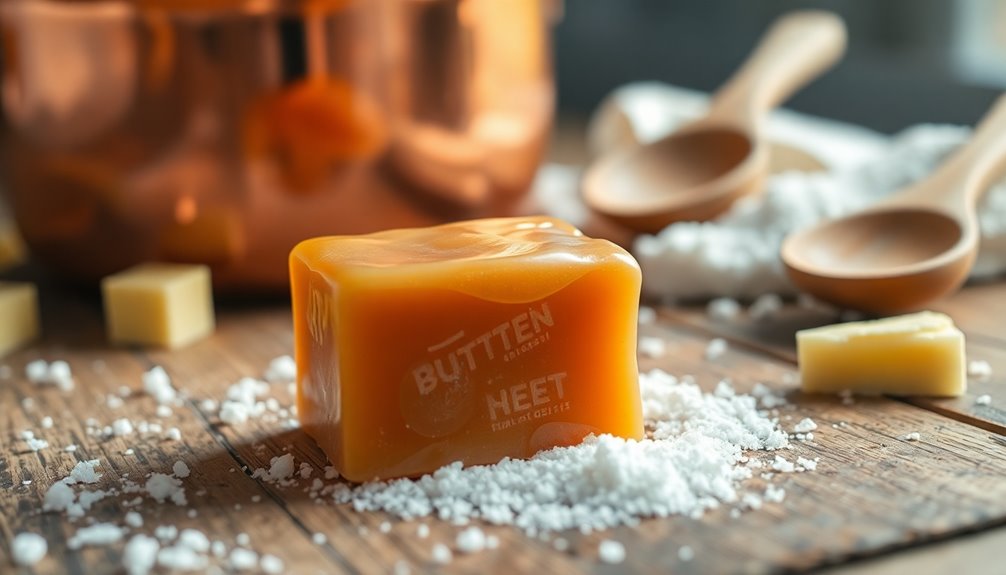
Butterscotch candy enthusiasts often have questions about perfecting their treats. One common concern is how to achieve the perfect texture. To make butterscotch candy, you need to guarantee the sugar fully dissolves and maintain a consistent temperature while you boil over medium heat. Stir constantly to prevent any graininess.
Here's a quick reference table for some common issues:
| Common Issue | Solution |
|---|---|
| Grainy texture | Guarantee sugar is fully dissolved |
| Fat separation | Mix ingredients thoroughly |
| Melting after storage | Store in an airtight container in a cool, dry place |
Another frequently asked question is about cooking time. Keep an eye on the temperature, aiming for 270°F to 300°F. If the temperature fluctuates, it can affect the candy's consistency. To prevent melting, guarantee you store your butterscotch candy properly. With these tips, you'll be well on your way to creating irresistibly sweet treats at home!
Ingredient Substitutions
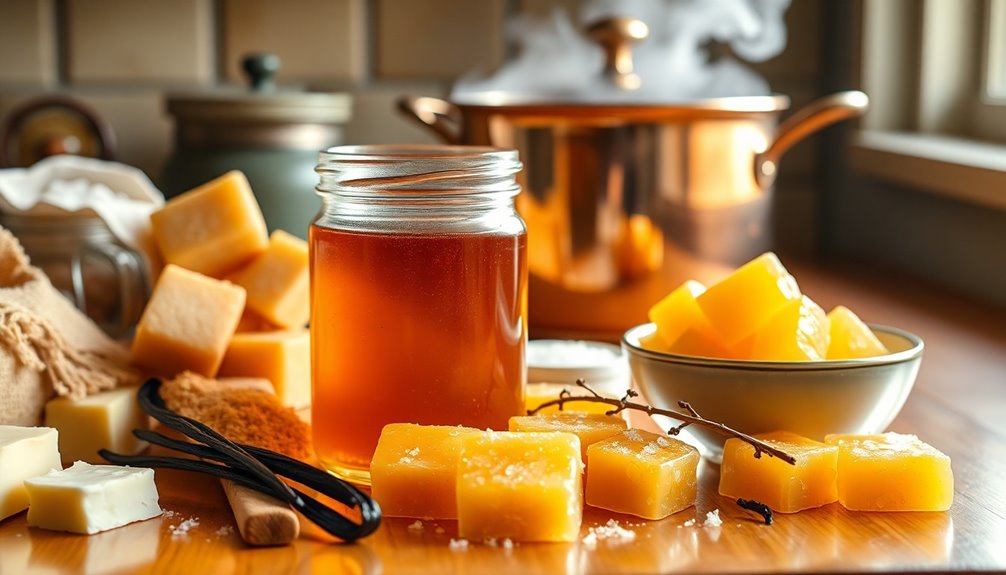
If you find yourself short on some ingredients while making butterscotch candy, don't worry—there are plenty of substitutions that can work just as well.
Here's a handy list of alternatives that maintain the deliciousness of your treat:
- Unsalted Butter: Use margarine or coconut oil for a dairy-free option while keeping a similar texture.
- Brown Sugar: Mix white sugar with molasses to mimic the flavor profile and moisture content of brown sugar.
- Heavy Cream: Swap it out for evaporated milk or coconut cream for a lighter or dairy-free version.
- Corn Syrup: Honey or maple syrup can add sweetness and help prevent crystallization in your candy mixture.
Don't forget about flavor! If you're out of vanilla extract, consider using almond or maple extract for a unique twist.
These substitutions allow you to create irresistible butterscotch candy without sacrificing taste or texture. Enjoy your candy-making adventure!
Variations and Experimentation
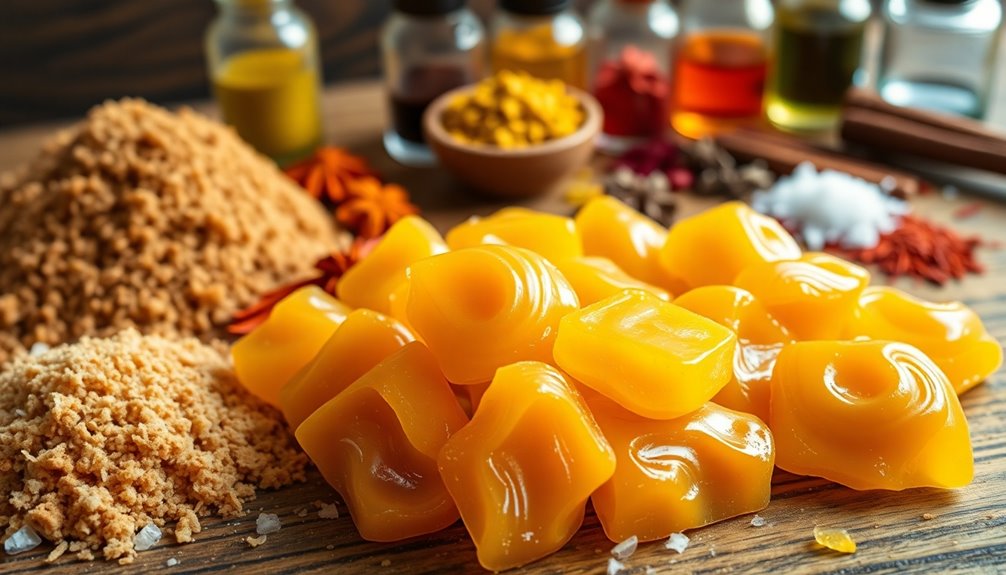
Once you've got your butterscotch candy basics down, it's time to get creative with variations and experimentation. Start by experimenting with different types of sugar, like brown sugar or even coconut sugar, to tweak the sweetness and depth of the butterscotch flavor.
Adding warm spices such as cinnamon or nutmeg can introduce a cozy complexity that elevates your candy.
Think about texture too! Before pouring your mixture into the baking pan, toss in some chopped nuts, like pecans or almonds, for a delightful crunch. If you're a chocolate lover, don't hesitate to drizzle melted chocolate over the cooled candy or fold in chocolate chips before it sets for a rich twist.
You can also play with alternative extracts. Swap out the traditional rum extract for almond or maple extract to create unique flavor profiles that'll surprise your taste buds.
The beauty of making your own butterscotch is that you can tailor it to your preferences. Once you've experimented, just remember to store your treats in an airtight container to keep them fresh and delicious!
Storage Tips
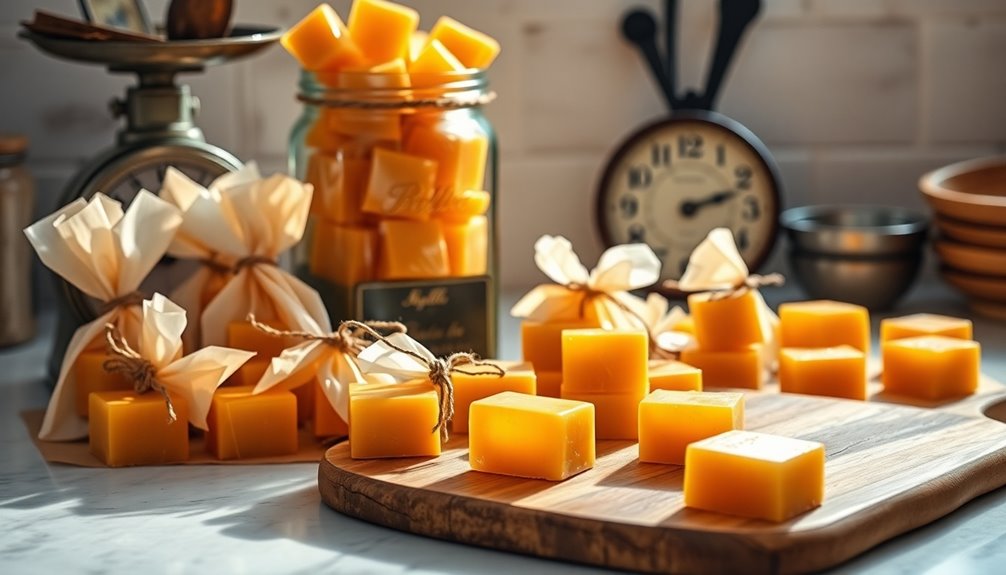
To keep your homemade butterscotch candy fresh and tasty, store it in an airtight container at room temperature. This method helps prevent moisture absorption, which can lead to graininess and spoilage.
Here are some essential storage tips to guarantee your candy stays delightful:
- Choose the Right Spot: Keep your candy in a cool, dry place, away from direct sunlight or heat sources. This way, you'll avoid melting or stickiness.
- Layer Protection: Separate layers of candy with parchment paper. This prevents them from sticking together and maintains their perfect texture.
- Long-term Storage: For longer preservation, wrap each piece in wax paper and place them in a freezer-safe bag. Don't forget to label it with the date for easy reference.
- Avoid Refrigeration: Resist the urge to refrigerate your butterscotch candy. The moisture from the fridge can lead to unwanted graininess and alter the texture over time.
User Experiences
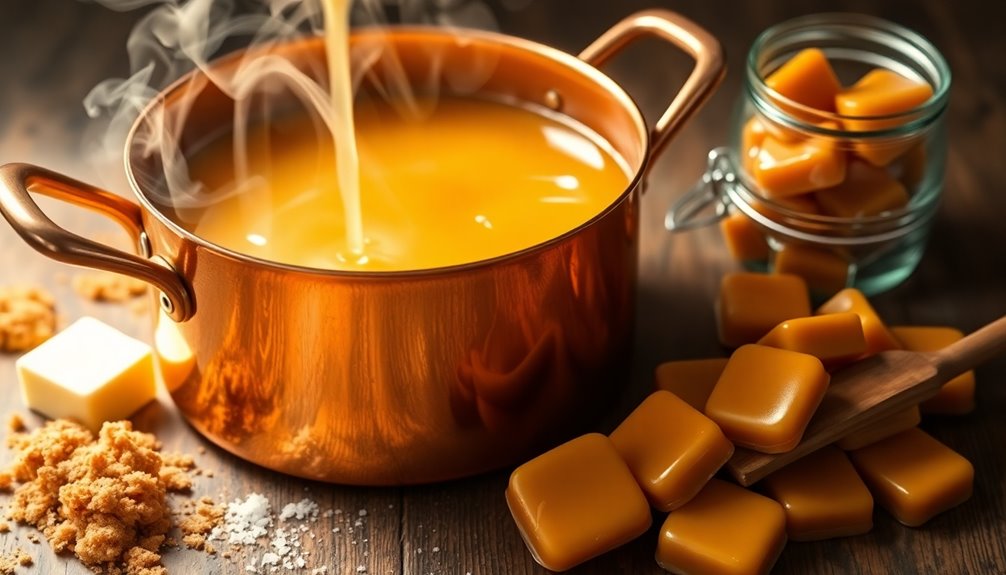
Many families have created lasting candy-making memories while tackling this butterscotch recipe together.
You might find it fun to experiment with flavors, like adding spices or omitting vinegar, to find your perfect taste.
However, be prepared for some cooking challenges along the way, as users have shared their ups and downs during the process.
Family Candy-Making Memories
Gathering in the kitchen to make butterscotch candy can transform an ordinary day into a memorable family event. You'll find that this straightforward recipe encourages everyone to participate, making it feel like a fun chemistry experiment.
As you measure, mix, and monitor temperatures together, you'll create not just delightful homemade butterscotch candy but also priceless family memories. Furthermore, enjoying your homemade treats alongside classic holiday dishes like corn on the cob can enhance the overall experience of family gatherings.
Here are four ways to enhance your candy-making experience:
- Creative Collaboration: Encourage each family member to suggest unique variations, like adding spices or nuts, to personalize your batch.
- Baking Bonding: Share stories or jokes while you work, turning the kitchen into a hub of laughter and joy.
- Candy-Making Challenges: Set fun challenges, like who can pour the mixture the most creatively or who can guess the temperature right!
- Gift Giving: Package your finished candies as gifts for holidays or special occasions, adding even more meaning to your creations.
Flavor Experimentation Stories
As you create cherished memories in the kitchen, don't hesitate to experiment with flavors that can elevate your butterscotch candy to new heights. Many home cooks have found success by adding extracts like almond or maple, which can dramatically change the flavor profile of your mixture. Adding anti-inflammatory ingredients like turmeric could also make your sweet treats a little healthier. Additionally, incorporating chia seeds can enhance the nutritional value of your candy, providing a boost of omega-3 fatty acids. Using aromatherapy techniques, such as choosing essential oils with uplifting scents, can also enhance the joyful experience of candy-making.
If you're looking to enhance the warmth of your butterscotch candy, try incorporating spices such as cinnamon or nutmeg. These spices add complexity and depth to the sweet treat.
You might also want to reflect on adding chopped nuts, which not only provide a delightful crunch but also contrast beautifully with the sweetness of the candy. Some enthusiasts swear by using a mixture of brown sugar and white sugar, claiming it creates a richer, more caramelized taste that makes their butterscotch candy unforgettable.
Additionally, don't overlook the versatility of your creations. Many cooks have shared how they melt leftover butterscotch candy to drizzle over other desserts, expanding the uses of their handmade treats. This approach aligns with the concept of cookie categories, which helps in tracking user engagement and preferences for recipes.
With each batch, you can make something unique, experimenting with flavors and textures that suit your palate.
Cooking Challenges Encountered
While making butterscotch candy can be a rewarding experience, it often presents a series of cooking challenges that home cooks must navigate. Here are some common hurdles you might face:
- Temperature Control: Using a candy thermometer is essential to avoid graininess. If the temperature isn't just right, your candy may not set properly, leading to a less desirable texture that can be frustrating to achieve.
- Achieving the Right Texture: If your candy ends up too soft, it likely hasn't reached the hard-crack stage, which is 300°F. This can affect the overall texture and enjoyment, making it crucial to monitor the temperature accurately throughout the cooking process.
- Flavor Balance: The quality of your butter greatly impacts the richness of the flavor. Don't skimp on this ingredient; it's where much of the taste comes from, and using higher fat content butter can enhance the overall richness of your candy.
- Scoring: Scoring the candy while it cools helps you break it into pieces more easily, preventing it from shattering uncontrollably. This technique ensures that you have manageable pieces to enjoy or share.
Experimenting with different sweeteners or flavor extracts can also lead to unique variations of this classic treat, but be cautious. Each change can affect the texture and flavor balance, so take your time to find the perfect mix! Additionally, maintaining a clean cooking environment is crucial, as regular maintenance can prevent cross-contamination and ensure a successful candy-making process.
Nutritional Information

When enjoying butterscotch candy, it's important to take into account its nutritional information.
Each piece packs in around 144 calories and 21 grams of sugar, so moderation is key.
You'll want to keep in mind daily value breakdowns and any health considerations, especially if you're watching your sugar intake.
Daily Value Breakdown
Butterscotch candy is a delightful treat, but it's important to be mindful of its nutritional content. Each piece packs a punch with a high sugar content and caloric density that can add up quickly.
Here's a breakdown of what you get in a single piece of butterscotch candy:
- Calories: Approximately 144 calories per piece.
- Total Fat: 6 grams, including 4 grams of saturated fat.
- Cholesterol and Sodium: 17 milligrams of cholesterol and 109 milligrams of sodium.
- Carbohydrates: 23 grams, with 21 grams coming from sugars.
This butterscotch mixture, primarily made with brown sugar and butter, creates irresistibly sweet candy pieces.
Remember, it's best to store your delicious creations in an airtight container and let them cool until the candy is set. Given their tempting nature, enjoy butterscotch candies in moderation to avoid exceeding your daily caloric needs.
Keep in mind that nutritional values are based on a 2,000 calorie diet, and your individual requirements may vary. So indulge wisely!
Health Considerations
Understanding the health factors of butterscotch candy is essential for making informed choices about your diet. A single piece packs around 144 calories, primarily from sugar and fat. With about 6 grams of total fat—4 grams of which are saturated fat—this candy offers a rich, creamy texture, but it also raises concerns for those watching their fat intake.
Each piece contains 23 grams of carbohydrates, with a staggering 21 grams coming from sugar. This high sugar content means you should enjoy butterscotch candy in moderation, especially if you're managing dietary restrictions like diabetes.
The sodium level is relatively low at 109 milligrams, but it's still important to take into account in your overall dietary balance.
If you have specific health factors, such as heart health or weight management, you might want to limit your intake of butterscotch candy or explore alternatives with less sugar.
Always remember that while this candy can be a delightful treat, it's best enjoyed as an occasional indulgence rather than a regular part of your diet. Balancing your sweet tooth with healthier options will keep your snacking guilt-free!
Frequently Asked Questions
What Makes Butterscotch Flavoring?
Butterscotch flavoring comes from the delightful mix of brown sugar and butter, which creates that rich, caramel-like taste you love.
Adding corn syrup helps keep the texture smooth and prevents crystallization, enhancing the flavor profile.
If you want an extra layer, consider using rum extract for complexity or vanilla extract for a different twist.
You can even add honey for a floral sweetness, deepening that unique buttery richness that sets butterscotch apart.
Can Diabetics Eat Butterscotch Candy?
If you're diabetic, eating butterscotch candy isn't straightforward.
Traditional butterscotch is high in sugar, which can spike your blood glucose levels. You might want to contemplate sugar-free alternatives or recipes using sugar substitutes like erythritol or stevia.
Portion control is key, so even a small amount can impact your sugar levels. It's wise to consult with a healthcare provider or dietitian for tailored advice on including treats in your diet.
Can You Melt Down Butterscotch Candy?
Imagine you've got some leftover butterscotch candy from a party, and you want to use it in a dessert. Yes, you can melt down butterscotch candy!
Just remember to do it slowly over low heat. Use a microwave in short bursts or a double boiler to keep it smooth. Adding a bit of cream can make it creamier.
Use the melted candy right away, as it hardens quickly when cooled. Enjoy your creations!
What Is the Difference Between Caramel and Butterscotch?
The difference between caramel and butterscotch lies in their ingredients and flavors.
While caramel uses white sugar and has a sweet, straightforward taste, butterscotch combines brown sugar and butter, giving it a richer, more complex flavor.
You'll also notice texture differences; caramel can be chewy or hard, depending on how long it's cooked, while butterscotch is often made to be a hard candy or a sauce.
Understanding these nuances can enhance your culinary creations!
Conclusion
Now that you've mastered the art of making butterscotch candy, you can impress friends and family with your sweet creations! Did you know that the average American consumes about 22 teaspoons of sugar a day? By making your own treats, you can control the ingredients and indulge guilt-free. So, gather your supplies and start experimenting with flavors and textures. Your homemade butterscotch delights are sure to bring smiles and joy to everyone who tries them!
